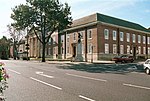Worthing Pier
Art Deco architecture in EnglandBuildings and structures in WorthingBurned buildings and structures in the United KingdomGrade II listed buildings in West SussexPier fires ... and 5 more
Piers in SussexStreamline Moderne architecture in the United KingdomTourist attractions in West SussexUse British English from December 2016Worthing

Worthing Pier is a public pleasure pier in Worthing, West Sussex, England. Designed by Sir Robert Rawlinson, it was opened on 12 April 1862 and remains open to the public. The pier originally was a simple promenade deck 960 ft (290 m) long and 15 ft (4.6 m) wide. In 1888 the pier was upgraded with the width increased to 30 ft (9.1 m) and the pier head increased to 105 ft (32 m) for a 650-seat pavilion to be built. It is a Grade II listed building structure. The pier has been named Pier of the Year by the National Piers Society on two occasions, first in 2006 and again in 2019.
Excerpt from the Wikipedia article Worthing Pier (License: CC BY-SA 3.0, Authors, Images).Worthing Pier
Marine Parade,
Geographical coordinates (GPS) Address External links Nearby Places Show on map
Geographical coordinates (GPS)
| Latitude | Longitude |
|---|---|
| N 50.807316 ° | E -0.368923 ° |
Address
Worthing Pier
Marine Parade
BN11 3QA
England, United Kingdom
Open on Google Maps










